 |
 |
 |
| |
HCV/HBV Coinfected at Greater Risk in SMART
|
| |
| |
Reported by Jules Levin
4th IAS Conference, 22-25 July, Sydney, Australia
Opportunistic disease and mortality in patients co-infected with hepatitis C virus (HCV) and/or hepatitis B virus (HBV) in the SMART
(Strategic Management of Antiretroviral Therapy)
Study
"HBV+ and/or HCV+ participants at entry had a 3.8 fold crude relative risk of non-OD death compared with the remaining cohort"
Tedaldi E.1, Puoti M.2, Neuhaus J.3, Peters L.4, Rockstroh J.5, Klein M.6, Dore G.7, Mocroft A.8, Soriano V.9, Clotet B.10, Lundgren J.4, The SMART study group and INSIGHT
1Temple University School of Medicine, Philadelphia, United States, 2Institute of Infectious and Tropical Diseases, Brescia, Italy, 3School of Public Health, University of Minnesota, Minneapolis, United States, 4Copenhagen HIV Programme, Hvidovre University Hospital, Copenhagen, Denmark, 5Medizinische Universitaetsklinik, Bonn, Germany, 6Montreal Chest Institute, Royal Victoria Hospital, Montreal, Canada, 7National Centre in HIV Epidemiology and Clinical Research, University of New South Wales, Sydney, Australia, 8Royal Free and University College Medical School, London, United Kingdom, 9Service of Infectious Diseases, Hospital Carlos III, Madrid, Spain, 10Hospital Universitari Germans Trias I Pujol, Badalona, Spain
AUTHOR SUMMARY
The risk of Opportunistic Disease (OD) was comparable regardless of hepatitis status.
Conversely, whereas HCV and/or HBV infected constituted 17% of pts in SMART, almost half of all non-OD deaths occurred in this population
--i.e., the co-infected population had an underlying higher risk of non-OD deaths than the uninfected population (3.8-fold)
The relative harm of experiencing OD or non-OD deaths by being randomized to the DC versus the VS strategy was comparable regardless of hepatitis status
As the risk of non OD-deaths was higher in the co-infected population, the strategy of ART interruption is particularly unsafe in these patients
ABSTRACT
Objectives: In SMART, the risk of opportunistic disease (OD) and/or death was increased in the drug conservation (DC; interrupt antiretroviral therapy (ART) until CD4<250) group as compared to the viral suppression (VS; continued use of ART) group. Co-infection with HBV and/or HCV might affect the disease processes evaluated in SMART, and could explain the increased risk in the DC group.
Methods: Participants were classified as HBV+ if HBsAg+>6 months, and HCV+ if HCV-Ab+. The rate (/100 person-year) of events of interest was compared by baseline HBV/HCV status and DC/VS arm.
Results: Among 5472 enrollees, 922 (16.8%) were HBV+ and/or HCV+; stratified as follows: HBV+ (n=110; 2.0%); HCV+ (n=798; 14.6%) or HBV+/HCV+ (n=14; 0.25%). HBV+ and/or HCV+ patients were at increased risk of non-OD death compared with the remaining cohort, whereas the relative increased risk in the DC versus VS groups for all three endpoints was comparable in HBV+ and/or HCV+ patients versus uninfected patients (table). Comparable findings were observed when HBV+ patients were excluded. The three leading causes of non-OD deaths in HBV+ and/or HCV+ participants were unknown cause, substance abuse and non-AIDS cancers.
Conclusions: HBV+ and/or HCV+ participants at entry had a 3.8 fold crude relative risk of non-OD death compared with the remaining cohort. Approximately half of the non-OD deaths observed in SMART occurred in this subgroup constituting 17% of the entire cohort. Interruption of ART is particularly unsafe in subgroups such as HBV+ and/or HCV+ persons with an a priori high underlying risk of non-OD death.
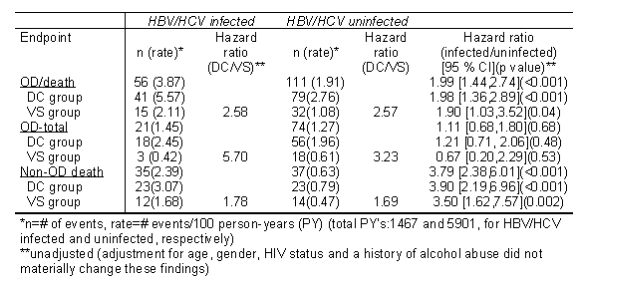
Study halted prematurely Jan 06
16 month average follow-up, 1.5% lost to follow-up
SMART study design
SMART, which is an acronym for Strategic Management of Antiretroviral Therapy, is a large randomized clinical trial, which studied CD4 cell count guided interruption of antiretroviral therapy.
5472 patients, with a CD4 cell count of more than 350/ml, were included and assigned to either continuous use of antiretroviral therapy (the viral suppression,VS, arm) or the drug conservation (DC) arm where the patients received episodic ART based on the CD4 cell count. In this group ART was deferred until the CD4 cell count decreased below 250 cells/ml and then the patients were on therapy until the CD4 cell count had increased to more than 350/ml.
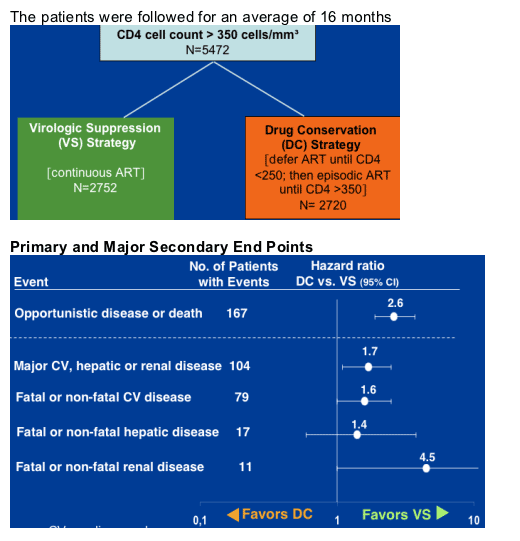
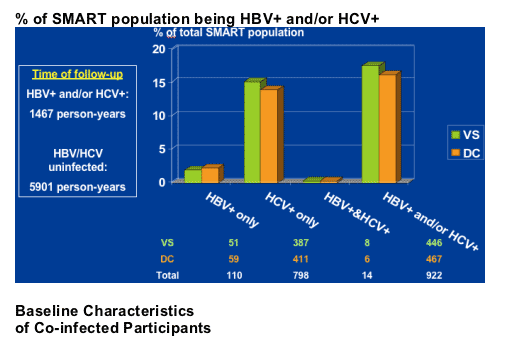
Rationale and Objective of this Presentation
Co-infection with hepatitis B and/or C and HIV can be associated with adverse effects on morbidity and survival.
Did co-infection with hepatitis B and/or C impact the outcomes of opportunistic disease (OD), morbidity or mortality seen in SMART?
--To compare the rate of total OD/death, OD and non-OD death by baseline hepatitis status and DC/VS group .
DEFINITIONS
Chronic HBV (HBV+)
--if HBV surface antigen positive over 6 months
Chronic HCV (HCV+)
--if HCV antibody positive.
HBV+ and/or HCV+
--Chronic HBV and/or HCV
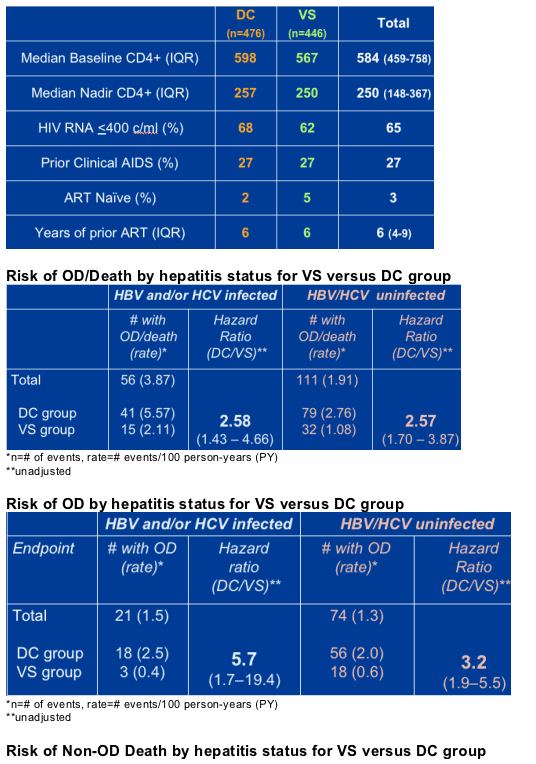
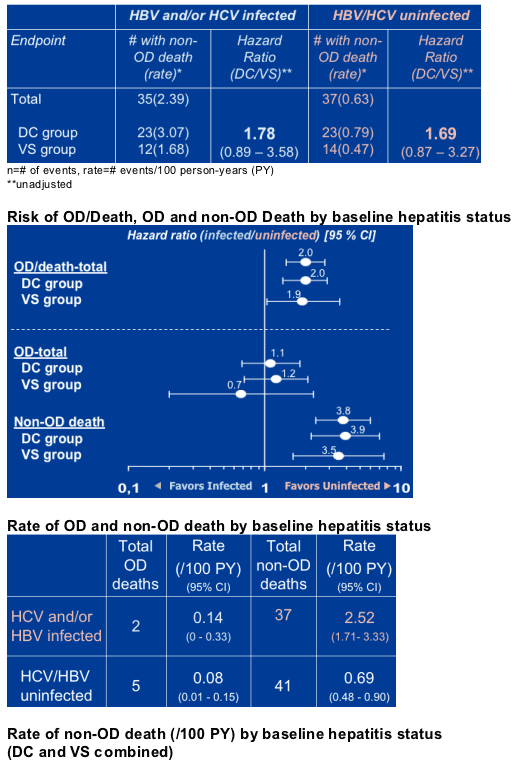
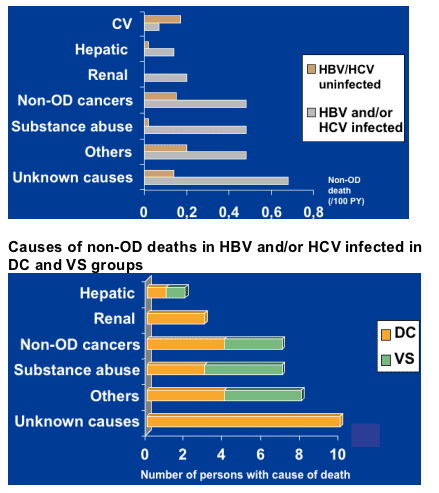
|
| |
|
 |
 |
|
|